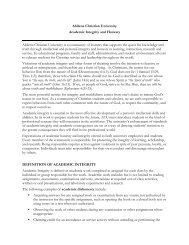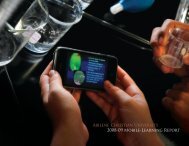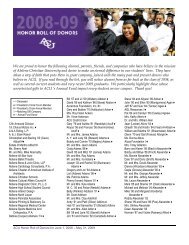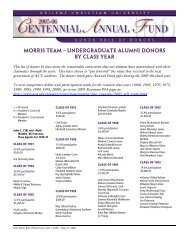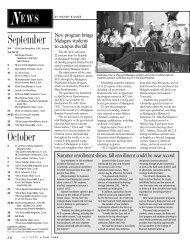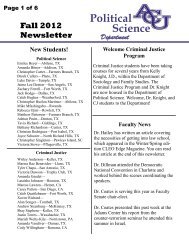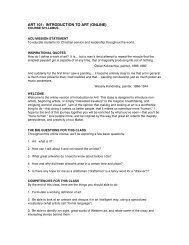The Influence of the Emperor Cult on the - Abilene Christian University
The Influence of the Emperor Cult on the - Abilene Christian University
The Influence of the Emperor Cult on the - Abilene Christian University
Create successful ePaper yourself
Turn your PDF publications into a flip-book with our unique Google optimized e-Paper software.
60 RESTORATION QUARTERLY<br />
important not <strong>on</strong>ly because it “became <str<strong>on</strong>g>the</str<strong>on</strong>g> center <str<strong>on</strong>g>of</str<strong>on</strong>g> <str<strong>on</strong>g>the</str<strong>on</strong>g> imperial cult in <str<strong>on</strong>g>the</str<strong>on</strong>g><br />
province <str<strong>on</strong>g>of</str<strong>on</strong>g> Asia,” but also because it “became <str<strong>on</strong>g>the</str<strong>on</strong>g> religious and political center<br />
20<br />
<str<strong>on</strong>g>of</str<strong>on</strong>g> <str<strong>on</strong>g>the</str<strong>on</strong>g> Koin<strong>on</strong> <str<strong>on</strong>g>of</str<strong>on</strong>g> Asia—<str<strong>on</strong>g>the</str<strong>on</strong>g> organizati<strong>on</strong> <str<strong>on</strong>g>of</str<strong>on</strong>g> <str<strong>on</strong>g>the</str<strong>on</strong>g> cities <str<strong>on</strong>g>of</str<strong>on</strong>g> Asia.” As <str<strong>on</strong>g>the</str<strong>on</strong>g> meeting<br />
place <str<strong>on</strong>g>of</str<strong>on</strong>g> <str<strong>on</strong>g>the</str<strong>on</strong>g> Koin<strong>on</strong> <str<strong>on</strong>g>of</str<strong>on</strong>g> Asia, Pergamum sp<strong>on</strong>sored annual games, <str<strong>on</strong>g>the</str<strong>on</strong>g> Romaia<br />
Sebasta, when <str<strong>on</strong>g>the</str<strong>on</strong>g> Koin<strong>on</strong> assembled. In additi<strong>on</strong>, <str<strong>on</strong>g>the</str<strong>on</strong>g> temple precincts “served<br />
as a repository for decrees <str<strong>on</strong>g>of</str<strong>on</strong>g> <str<strong>on</strong>g>the</str<strong>on</strong>g> Koin<strong>on</strong>, letters from Rome, and decrees<br />
h<strong>on</strong>oring provincial priests or o<str<strong>on</strong>g>the</str<strong>on</strong>g>r <str<strong>on</strong>g>of</str<strong>on</strong>g>ficials <str<strong>on</strong>g>of</str<strong>on</strong>g> <str<strong>on</strong>g>the</str<strong>on</strong>g> Koin<strong>on</strong>, with stelai set up <strong>on</strong><br />
21<br />
<str<strong>on</strong>g>the</str<strong>on</strong>g> temenos or even in <str<strong>on</strong>g>the</str<strong>on</strong>g> temple itself.” Unfortunately, no archaeological<br />
22<br />
evidence <str<strong>on</strong>g>of</str<strong>on</strong>g> <str<strong>on</strong>g>the</str<strong>on</strong>g> temple has been unear<str<strong>on</strong>g>the</str<strong>on</strong>g>d. Despite <str<strong>on</strong>g>the</str<strong>on</strong>g> absence <str<strong>on</strong>g>of</str<strong>on</strong>g> archaeological<br />
evidence, <str<strong>on</strong>g>the</str<strong>on</strong>g> c<strong>on</strong>fluence <str<strong>on</strong>g>of</str<strong>on</strong>g> <str<strong>on</strong>g>the</str<strong>on</strong>g> literary evidence from Dio and Tacitus with <str<strong>on</strong>g>the</str<strong>on</strong>g><br />
23<br />
numismatic evidence render <str<strong>on</strong>g>the</str<strong>on</strong>g> existence <str<strong>on</strong>g>of</str<strong>on</strong>g> <str<strong>on</strong>g>the</str<strong>on</strong>g> temple in Pergamum virtually<br />
certain.<br />
Laodicea<br />
<str<strong>on</strong>g>The</str<strong>on</strong>g> evidence for an imperial temple in Laodicea is entirely numismatic.<br />
For instance, F. Imho<str<strong>on</strong>g>of</str<strong>on</strong>g>-Blumer describes <strong>on</strong>e <str<strong>on</strong>g>of</str<strong>on</strong>g> <str<strong>on</strong>g>the</str<strong>on</strong>g> coins found at Laodicea:<br />
Obverse: in a circular legend and<br />
in <str<strong>on</strong>g>the</str<strong>on</strong>g> field . Facing busts <str<strong>on</strong>g>of</str<strong>on</strong>g> Domitian victorious and breastplated<br />
<strong>on</strong> <str<strong>on</strong>g>the</str<strong>on</strong>g> right and Domitia in draped clothing <strong>on</strong> <str<strong>on</strong>g>the</str<strong>on</strong>g> left.<br />
Reverse: . —. Temple with four columns, <str<strong>on</strong>g>of</str<strong>on</strong>g><br />
which <str<strong>on</strong>g>the</str<strong>on</strong>g> frieze carries <str<strong>on</strong>g>the</str<strong>on</strong>g> inscripti<strong>on</strong> ; inside Domitian stands <strong>on</strong> <str<strong>on</strong>g>the</str<strong>on</strong>g><br />
left in military dress; Domitia stands <strong>on</strong> <str<strong>on</strong>g>the</str<strong>on</strong>g> right; each <strong>on</strong>e is supported by a<br />
scepter and extends his/her hand [trans. mine]. 24<br />
Imho<str<strong>on</strong>g>of</str<strong>on</strong>g>-Blumer notes that <str<strong>on</strong>g>the</str<strong>on</strong>g> first phrase <strong>on</strong> <str<strong>on</strong>g>the</str<strong>on</strong>g> reverse probably indicates <str<strong>on</strong>g>the</str<strong>on</strong>g><br />
magistrate in whose reign <str<strong>on</strong>g>the</str<strong>on</strong>g> coin was stamped. More important is <str<strong>on</strong>g>the</str<strong>on</strong>g> inscripti<strong>on</strong><br />
<strong>on</strong> <str<strong>on</strong>g>the</str<strong>on</strong>g> temple frieze. Imho<str<strong>on</strong>g>of</str<strong>on</strong>g>-Blumer gives <str<strong>on</strong>g>the</str<strong>on</strong>g> following interpretati<strong>on</strong>:<br />
<str<strong>on</strong>g>The</str<strong>on</strong>g> adjective seems to refer to <str<strong>on</strong>g>the</str<strong>on</strong>g> temple () which <str<strong>on</strong>g>the</str<strong>on</strong>g> frieze<br />
decorates. Since <str<strong>on</strong>g>the</str<strong>on</strong>g> emperor represents himself in military costume, carrying a<br />
trophy, between <str<strong>on</strong>g>the</str<strong>on</strong>g> columns <str<strong>on</strong>g>of</str<strong>on</strong>g> <str<strong>on</strong>g>the</str<strong>on</strong>g> building, it is permissible to believe that <str<strong>on</strong>g>the</str<strong>on</strong>g><br />
20 R<strong>on</strong>ald Mellor, : <str<strong>on</strong>g>The</str<strong>on</strong>g> Worship <str<strong>on</strong>g>of</str<strong>on</strong>g> <str<strong>on</strong>g>the</str<strong>on</strong>g> Goddess Roma in <str<strong>on</strong>g>the</str<strong>on</strong>g> Greek<br />
World (Göttingen: Vandenhoeck & Ruprecht, 1975), 80.<br />
21 Mellor, Roma, 81, 141.<br />
22 Note <str<strong>on</strong>g>the</str<strong>on</strong>g> silence <str<strong>on</strong>g>of</str<strong>on</strong>g> J. Schäfer, “Pergam<strong>on</strong>,” Princet<strong>on</strong> Encyclopedia <str<strong>on</strong>g>of</str<strong>on</strong>g> Classical<br />
Sites, 688–92. Schäfer does menti<strong>on</strong> “a room which served for <str<strong>on</strong>g>the</str<strong>on</strong>g> cult <str<strong>on</strong>g>of</str<strong>on</strong>g> <str<strong>on</strong>g>the</str<strong>on</strong>g> emperor”<br />
(689). Mellor, Roma, 141.<br />
23 See Friesen, Imperial <str<strong>on</strong>g>Cult</str<strong>on</strong>g>s, 29–30.<br />
24 F. Imho<str<strong>on</strong>g>of</str<strong>on</strong>g>-Blumer, M<strong>on</strong>naies grecques (Amsterdam: Johannes Müller, 1883),<br />
404–5. <str<strong>on</strong>g>The</str<strong>on</strong>g> episil<strong>on</strong>s are lunate, which I have approximated by enlarging a small-case<br />
episil<strong>on</strong>. Also, <str<strong>on</strong>g>the</str<strong>on</strong>g> KOP is a m<strong>on</strong>ogram.



